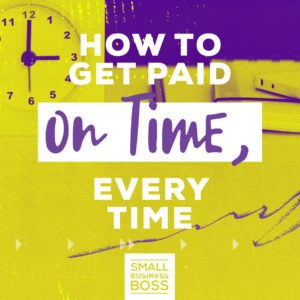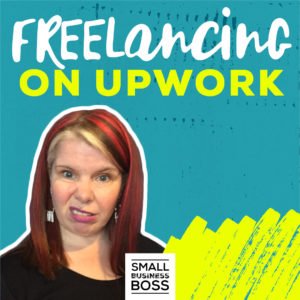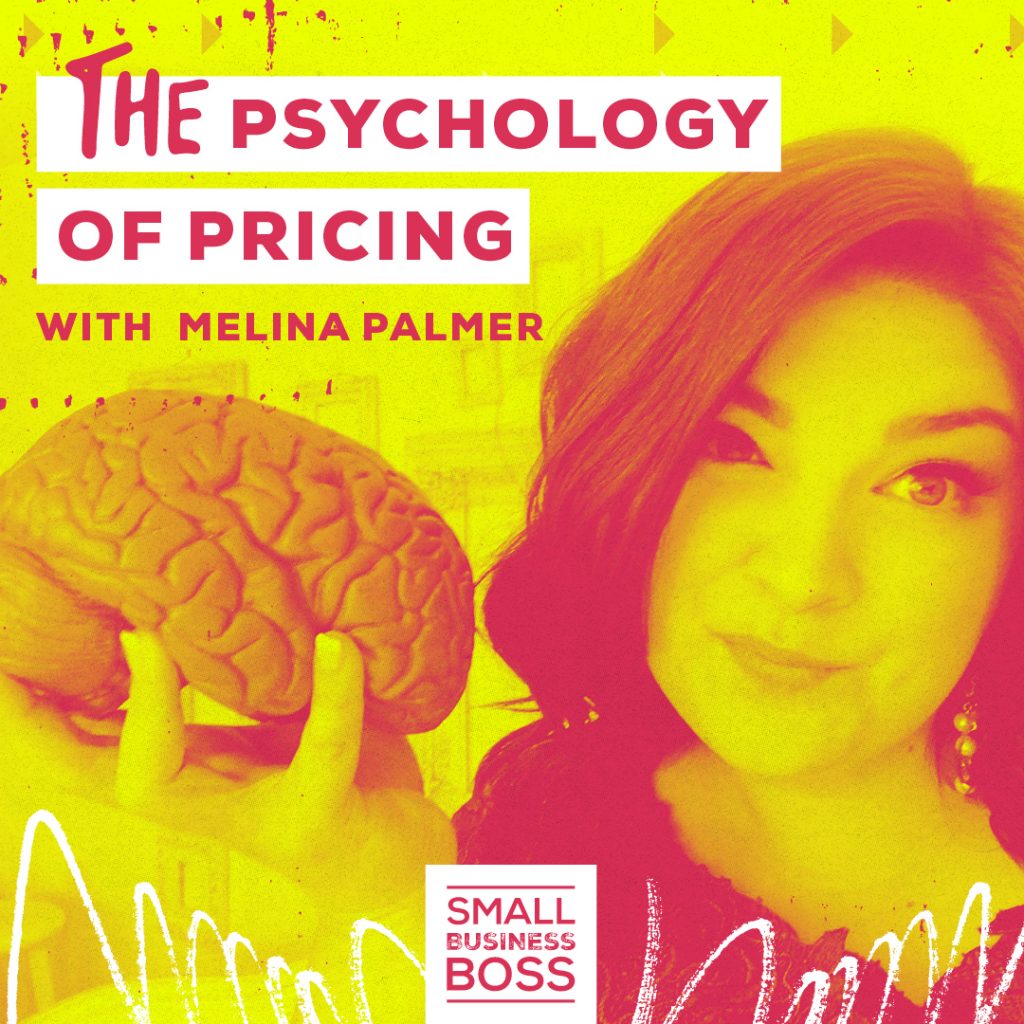
Search the site:
Episode 147: The Psychology of Pricing with Melina Palmer
If there’s one thing that service business owners struggle with, it’s pricing our services. We have so much wrapped up in pricing and the story around it, that it can be hard to charge what we should be charging and to stand in our value. To help with that challenge, I recently sat down with an expert on the psychology of pricing, Melina Palmer, to learn more.
A few weeks ago in a session with the Small Business Boss Society, pricing came up as a real struggle for most people. And I get it. I really do. I also have my moments when it comes to figuring out how much to charge for services.
Pricing is a complex challenge in our business, and to be able to nail our pricing, we need to be able to understand why we’re stuck and what story our pricing tells to our would-be clients. Melina is going to help us learn more about the psychology of pricing and more.
Before we dive in, a bit about Melina’s business. She helps businesses and entrepreneurs to understand what behavioral economics is, which is essentially how the brain works and makes buying decisions. She does a lot of speaking engagements and also one-on-one consulting with companies or businesses — often marketing departments and agencies.
Why Is Pricing so Challenging?
According to Melina, pricing is “difficult for people because there are a lot of mindset pieces that you’re having to get over yourself, and in a lot of cases, you’re not your ideal customer. Because something comes really easy to you, you can have a difficult time placing the proper value on what somebody else would put onto your services.”
She goes on to add that, “If you’re not willing to pay your price, it doesn’t mean it’s the wrong price. It’s because you don’t need that service, but somebody else does, and being able to get yourself into the mindset of the value you provide for people can be really difficult.”
Understanding the Value of Your Services
When it comes to pricing, one of the things that most service business owners struggle with is the idea of value. When I asked Melina about this, she explained that there’s a difference between value, price, and cost.
“They’re not the same thing. The truth is that all the stuff leading up to the price matters more than the price itself. All the stuff that leads up to the product, management of the product, and the way it’s presented can make a really big difference for people, and the story I give for this is it’s not about the cookies.”
Melina explains further, “Let’s say you and I are walking down the street. We’re having a great conversation, and all of a sudden, we start to smell fresh baking cookies. You can feel yourself looking around, trying to find them, ‘Where’s that coming from? What is that?’ By the time we get in front of the store, and we walk inside, and we see it, they give us a free sample. It’s buy three, get one free, and before we know it, we walk out each with four cookies.”
“In the reverse, we’re walking down the street and somebody comes up and shoves a flyer in our face and says, ‘Today only, four for the price of three, get them now, and look, I have free samples.’ You think, ‘Ugh, rude. Didn’t you see we were having a conversation?’ And by the time we smell them, we’re just irritated and maybe using that to write a Yelp review about how much we hate that place.”
“The thing is in those two scenarios, exactly the same things happened, but they’re just in the reverse order. In the first scenario, your brain, your subconscious bought the cookies before we even got there in the first place because it was very interested. It was shut down where it wasn’t going to buy in the second scenario — even though it’s potentially exactly the same product.”
The Conscious and Subconscious Minds
Melina helps people to understand that the subconscious brain actually makes 99% of all of our decisions — including buying decisions.
She gives an example of this at play in the online world: “If you have an ugly sales page with stretched out logos or pictures with your face all wonky, people’s subconscious picks up on that immediately and thinks, ‘Amateur,’ whether they actually can articulate that or not. It might come out in some other buying objection because our subconscious and conscious brains don’t actually really talk to each other very well. The subconscious will have made a decision for whatever reason, and it makes these decisions very quickly.”
“The conscious mind then has to explain why you had a gut feeling that you weren’t interested. Way too much content and big blocks of text are not typically impactful in any way. Your brain goes, ‘Nope’ and moves on. Whereas it’s constantly processing images and is able to dig into that and know how to build in the story and fill in gaps when really strong images are used in a way that you just can’t do with words.”
“Really good copy is hard, and it’s even more difficult to get concise copy. I forget, I think it was Mark Twain who wrote a letter to somebody and had apologized and said, ‘It would have been much shorter if I had more time to complete it,’ because it takes longer to do good, short copy.”
Our Brains Get Easily Overwhelmed
One of Melina’s favorite studies showed how quickly our brains get overwhelmed by having one group remember a two-digit number and another group remember a seven-digit number.
“In this study, they go through a series of rooms with tasks and have them tell the person at the end what their number was. One of those tasks was to choose a snack. The people remembering the two-digit number were more likely to choose the healthy snack of fruit salad, and the people remembering the seven-digit number were significantly more likely to choose chocolate cake as their snack.”
“If you can’t make a good decision when you’re remembering seven random digits, how is somebody supposed to process all that information you’re putting in front of them at one time?”
The Importance of Anchoring Your Prices
Often, when we price services, we only have one option, and Melina shares how this is actually hard for our customer’s brains to understand as we don’t know how to value what’s being offered.
Melina says, “A great example of this would be if we were to say you own a small electronics store, and in the store, you decide you want to buy an espresso machine and that you’re going to sell that now. You find a really great one — it’s the only one you have — and you put it on a shelf between a microwave and a blender, and it’s priced at $150. It sits there for six months, and nobody buys it. You might think it’s because people aren’t buying espresso machines, it’s not an option for people these days, and you would either discount it or just get rid of it. What you should actually do is get a different espresso machine that is twice the size and twice the price and put it right next to it. Now there’s this big one that’s $300, and somebody can look and say, ‘I haven’t used an espresso machine before, I’m not sure what’s a good one. This is so compact and easy. It would look so nice on my countertop, and instead of buying at Starbucks, I can make up $150 pretty reasonably.’
“They’re able to see that this is a good choice based on another espresso machine. When they don’t have this opportunity to value, the brain does those connections and those choices incredibly quickly, and when it doesn’t have that, it’ll just move on and file it in the, “I should think about that later” bank. I always advise to set up whatever your product is — you want to have it set up as the best option, the best thing that you can do — and then you make a decoy that is an obviously worse value — and ideally at a higher price point because it sets a high anchor and makes the thing you’re actually trying to sell look better. Everything should be pointing to that one thing that you’re trying to offer to people as the very best choice, and consider this other decoy product like its wing lady, hanging out.”
“Your subconscious brain, if you were to think about it like a computer, it makes decisions. It’s doing about 11 million bits of information per second. Your conscious brain can do about 40 compared to 11 million. That subconscious brain is constantly making choices and saying, ‘I know something about this, I have a rule for this.’ It’s saying, ‘Normal, normal, normal, normal, normal, normal,’ and then it will flag your conscious brain when there’s something interesting enough for it to pay attention to.
“For example, you’re driving down the street and a semi truck comes into your lane. You’re now very focused and that is because your subconscious said, ‘Hey, hey, time to focus. We need to work on this now.’ But it’s making these decisions all the time about pricing and what it wants to buy, and that’s what I help people to understand.”
Being Confident About Your Pricing
When I asked Melina her biggest tip for being confident about your pricing, she shared this idea: “You have to be able to say your price like you’re saying the weather. It needs to be with absolute confidence and be able to put it out there. If you’re at a price now that you know is too low and you know you have to be able to get up to a certain price, you need to be able to say that this is what everybody buys, and you have to know that it’s a great value for people, and have the confidence to say it so that they can hear and feel it’s a good deal for them. If there’s any hint of, ‘I don’t know. Maybe. I just raised my prices,’ they’re not going to buy. It’s all about the way it’s presented — not the price itself.
“Discounts should never be a crutch. If you are having to say, ‘Well, it’s $499, but I’ll go ahead and do it for $200,’ you’re not actually charging whatever it is that you say that you’re charging, and you need to have some pricing integrity. It’s okay to do discounts from time to time, but there needs to be strategy in that and why you’re offering it. If you don’t have that strategy, then you’re just cheap for no reason. There’s no reason to cut the price.
“People taking an aspirin that they’ve been told costs one cent versus an aspirin that they’ve been told costs a dollar, — where of course they’re exactly the same thing — they will say it works faster, it works better, they like it more, great effects from the one that cost more money versus the one that was at a discount. People do associate value with cost. Our brain sets expectations on things, and the brain gets what it expects.”
SUMMARY: Three Pricing Psychology Lessons
- You are NOT your customer. Melina shared how it’s easy for us to let our own mindset get in the way of pricing our services. Pricing starts with understanding WHY your client buys and what value you’re delivering.
- Pricing is about what happens before the price. The price is about so much more than the money. Melina shared the story about the cookies, so use that as a way to think about how to frame up your price better so that the price is really not a factor when it gets to that point in the discussion.
- Anchoring your price can be powerful. So many times we offer a single option to our clients, and they have no basis for comparison. Using a decoy or another option to compare against helps demonstrate the value of what we’re offering.
Links for the Show:
About Melina Palmer
Why do people say one thing and do another? What really drives behavior? How does the brain actually work — and how can we best communicate with it? What does that mean for companies? Melina Palmer, host of The Brainy Business podcast, has dedicated her career to seeking answers to these questions for herself and her clients. Melina uses behavioral economics to help companies and entrepreneurs understand the psychology of why people buy, unlocking the secrets of small changes that make a big difference. The result is messaging, branding, advertisements, pricing, and products that are more “brain friendly” (meaning more leads, conversions, and revenue).
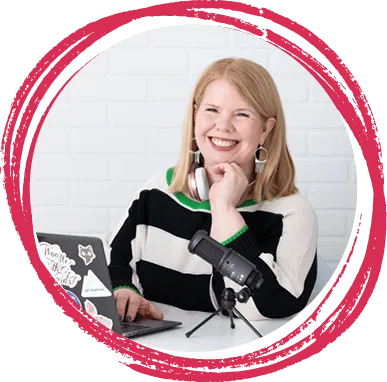
I’m Maggie Patterson (she/her), and services businesses are my business.
I have 20+ years of experience with client services, am a consultant for agency owners, creatives, and consultants, and vocal advocate for humane business practices rooted in empathy, respect, and trust.
Read or Listen to the Latest
For Solo Business Owners
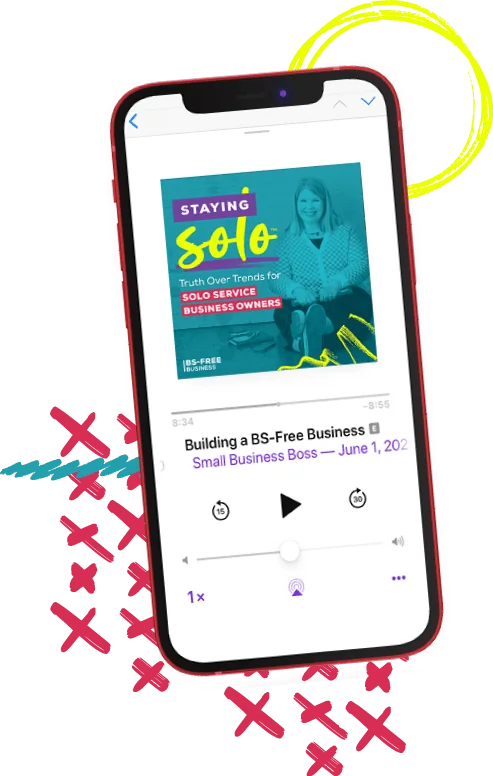
Growing a solo service business is tough.
It’s even harder when you’re bombarded with BS advice that steers you away from your values and why you started your business in the first place.
This is the podcast for solo creatives and consultants who want to remain as a team of one and have zero interest in the hustle and grind of typical business teachings.
Subscribe now and never miss an episode.
For Micro Agency Owners
Most podcasts for agency owners obsess over revenue growth as the ultimate success metric.
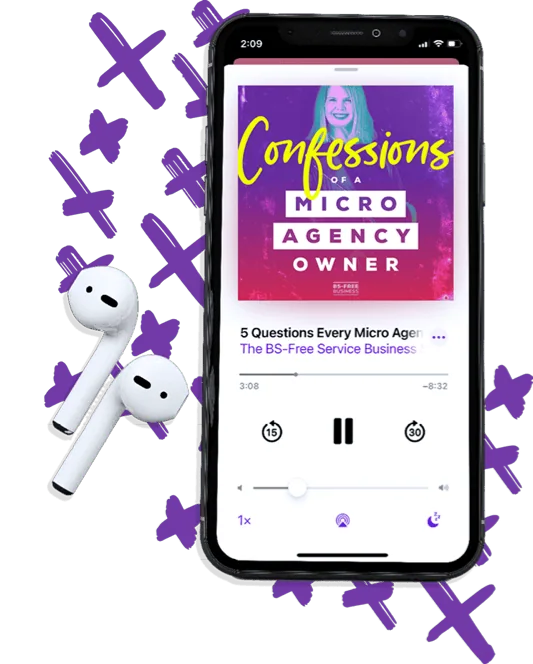
But here’s the truth: not everyone wants to make millions. Your goal might be to build a sustainable business that lets you have a life and doesn’t run you into the ground.
Join me as I spill my shameless confessions and share everything I’ve learned about building a micro agency that skips the BS of tired and typical agency teachings.
Follow Now on All Major Podcast Platforms




